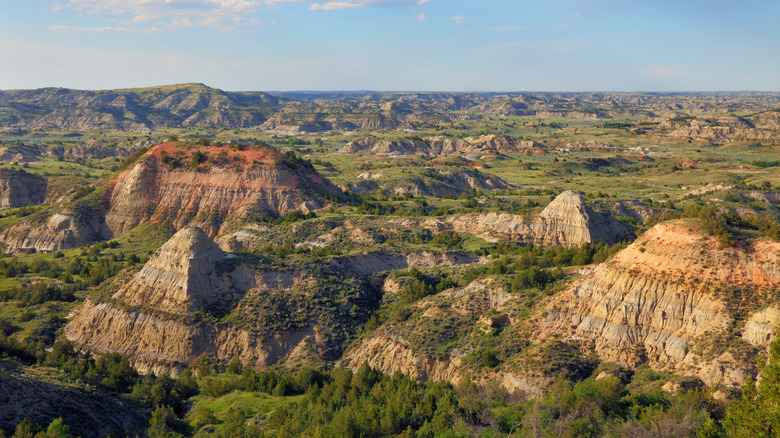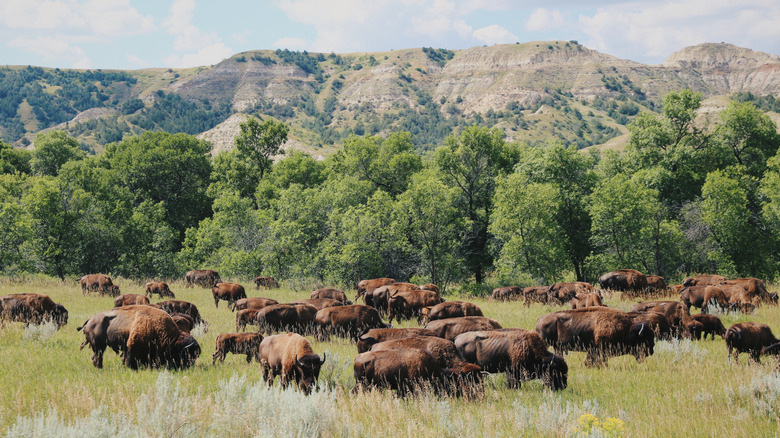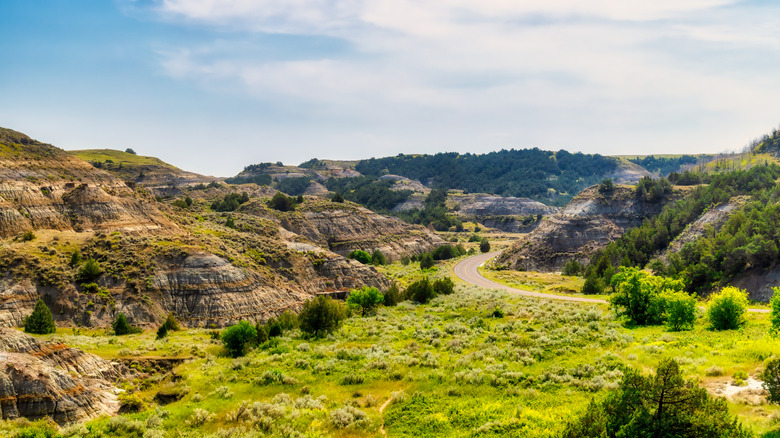One Of America's Most Underrated National Park Trails Is An Easy Hike With North Dakota's Best Landscapes
In 1883, future President Theodore Roosevelt came to the Badlands of North Dakota to hunt bison, and the rugged beauty shaped his views of the natural world that would lead to policies that would become his legacy. Years after his presidency, a national park bearing his name was established there, to honor his legacy as a conservationist and his contributions to the creation of the National Park Service. Theodore Roosevelt National Park encompasses 70,000 acres of picturesque buttes, cliffs, canyons, and rivers in the far western part of North Dakota. It's relatively out-of-the-way location means the park sees only a fraction of the visitors of many of its western counterparts. But its stunning landscapes, interesting wildlife, history and lack of crowds make it a true hidden gem in the national parks system.
The U.S. national parks have thousands of miles of hiking trails that take visitors through some of the most incredible natural scenery on earth. But one of the most underrated trails is located right in Theodore Roosevelt National Park. The Boicourt Overlook Trail is a 0.2-mile out-and-back trail that leads you to one of the best views in the entire park. A paved trail, it's accessible for most visitors, and also offers the opportunity to glimpse one of the most iconic animals of the American West, the bison.
Theodore Roosevelt National Park is located on the far western side of North Dakota, just off Interstate 94. By car, it's about two hours west of Bismark and about a four-hour drive northeast of Billings, Montana. Whether you're visiting North Dakota, or just passing through on a road trip, it's worth stopping at this national park and hitting the trail to experience the seriously underrated North Dakota Badlands park.
Experience the rugged beauty of the North Dakota Badlands
Theodore Roosevelt National Park is divided into three sections: The North Unit and the South Unit offer hikes, scenic drives, a visitor centers with amenities, and the undeveloped Elkhorn Ranch Unit, which marks the site of Roosevelt's North Dakota ranch. The Boicourt Trail is in the South Unit, the largest of the three and the most visited, as it's right off the main highway. The trailhead is located approximately halfway along the South Unit scenic drive, so it's a great place to stop and stretch your legs and experience the best views of the Badlands the park has to offer. It takes about two hours to drive the entire 36-mile scenic loop, but budget extra time if you're planning to hike the Boicourt Trail or any others along the way.
From the trailhead, a paved trail brings you out along the edge of the cliffs to a scenic overlook. There, you'll be treated a panoramic view of the Badlands with its colorful buttes and grasslands. The paved trail ends after 0.2 miles. After that, you'll be able to continue on along an unpaved portion of the trail to another overlook, or turn around and head back to your vehicle and continue driving the scenic loop. This trail is one of the best spots in the park to watch the sunset over the Badlands, according to the park rangers.
Theodore Roosevelt National Park is one of the best national parks to see wildlife. As you hike (or drive), be on the lookout for the bison, elk, and mule deer that freely roam the park as well as prairie dogs, pronghorn deer, and bald eagles, and gold eagles. Keep in mind, as is the case in many national parks, dogs are not permitted on any of the trails in Theodore Roosevelt National Park.
Tips for visiting Theodore Roosevelt National Park
Theodore Roosevelt National Park has more than 100 miles of hiking trails to explore. If you're approaching the park from the east on I-94, the first place you'll encounter is the Painted Canyon Visitor Center. The short Painted Canyon Natural Trail brings you from the parking lot along the rim down into the canyon along a loop trail, where you'll be able to admire the colorful layers of rock up close. Also in the South Unit, the 0.4-mile Wind Canyon Trail ascends to an incredible view of the mighty Little Missouri River and is another great place to watch the sunset. Head to the North Unit for more hiking, including backcountry trails. This is where you'll find the Caprock Coulee Trail, one of the most popular in the park. The 4-mile trail leads hikers through the Badlands and past many interesting geological formations that have been shaped by erosion over thousands of years. If you're feeling more adventurous, there's the Maah Daah Hey Trail, a nearly 150-mile hiking, horseback riding, and mountain biking trail that traverses across the rugged hills and rolling grasslands of North Dakota. The trail runs through all three units of the park.
Theodore Roosevelt National Park has three campgrounds, Cottonwood Campground and Roundup Group Horse Camp in the South Unit and Juniper Campground in the North Unit. In Cottonwood Campground, half the sites are reservable online while the other half are first come, first served. In Juniper Campground, all 50 sites are first come, first served, outside of the one group site that can be reserved online. Backcountry camping is also allowed in the park. You'll need to pickup a free permit at either the North or South Unit visitor centers. You can camp almost anywhere in the park, but review the regulations when obtaining your permit. Outside the park, there are also a handful of campsites in Rough Rider State Park if you want to spend a night outside under the stars.
There's lots to experience outside Theodore Roosevelt National Park as well. Medora, the tiny North Dakota town that serves as the gateway to the national park, has plenty of local shops and restaurants for visitors to enjoy. But the town's biggest tourist attraction is the "Medora Musical," a country-western extravaganza that tells the history of Theodore Roosevelt, Medora, and the American West. The family-friendly show, which is in its 60th year, is performed outdoors at the Burning Hills Amphitheatre against the backdrop of the Badlands, a little over a mile outside of town.


